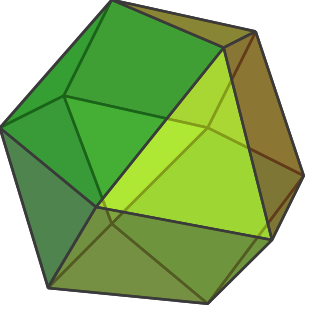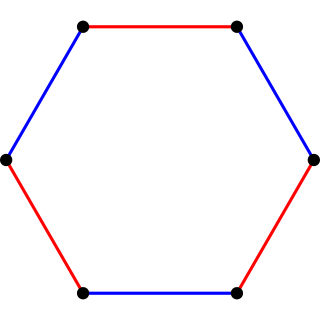Regular
All the faces are identical, each edge is identical and each vertex is identical. They all have a Wythoff symbol of the form p|q 2.
Convex
The Platonic solids.
| | | | |
Non-convex
The Kepler-Poinsot solids.
| | | |
| Polyhedron | |
| Class | Number and properties |
|---|---|
| Platonic solids | (5, convex, regular) |
| Archimedean solids | (13, convex, uniform) |
| Kepler–Poinsot polyhedra | (4, regular, non-convex) |
| Uniform polyhedra | (75, uniform) |
| Prismatoid: prisms, antiprisms etc. | (4 infinite uniform classes) |
| Polyhedra tilings | (11 regular, in the plane) |
| Quasi-regular polyhedra | (8) |
| Johnson solids | (92, convex, non-uniform) |
| Pyramids and Bipyramids | (infinite) |
| Stellations | Stellations |
| Polyhedral compounds | (5 regular) |
| Deltahedra | (Deltahedra, equilateral triangle faces) |
| Snub polyhedra | (12 uniform, not mirror image) |
| Zonohedron | (Zonohedra, faces have 180°symmetry) |
| Dual polyhedron | |
| Self-dual polyhedron | (infinite) |
| Catalan solid | (13, Archimedean dual) |
There are many relations among the uniform polyhedra.
Here they are grouped by the Wythoff symbol.
Image |
All the faces are identical, each edge is identical and each vertex is identical. They all have a Wythoff symbol of the form p|q 2.
The Platonic solids.
| | | | |
The Kepler-Poinsot solids.
| | | |
Each edge is identical and each vertex is identical. There are two types of faces which appear in an alternating fashion around each vertex. The first row are semi-regular with 4 faces around each vertex. They have Wythoff symbol 2|p q. The second row are ditrigonal with 6 faces around each vertex. They have Wythoff symbol 3|p q or 3/2|p q.
| | | |
| | |
Each vertex has three faces surrounding it, two of which are identical. These all have Wythoff symbols 2 p|q, some are constructed by truncating the regular solids.
| | | | |
| | | | |
The hemipolyhedra all have faces which pass through the origin. Their Wythoff symbols are of the form p p/m|q or p/m p/n|q. With the exception of the tetrahemihexahedron they occur in pairs, and are closely related to the semi-regular polyhedra, like the cuboctohedron.
| | | | |
| | | |
Four faces around the vertex in the pattern p.q.r.q. The name rhombic stems from inserting a square in the cuboctahedron and icosidodecahedron. The Wythoff symbol is of the form p q|r.
 Rhombicuboctahedron | | | |
 Rhombicosidodecahedron | | | |
| | | |
| |
These have three different faces around each vertex, and the vertices do not lie on any plane of symmetry. They have Wythoff symbol p q r|, and vertex figures 2p.2q.2r.
| | | |
| | | |
Vertex figure p.q.-p.-q. Wythoff p q (r s)|, mixing pqr| and pqs|.
| | | |
| | |
These have Wythoff symbol |p q r, and one non-Wythoffian construction is given |p q r s.
| Symmetry group | |||
|---|---|---|---|
| O | | ||
| Ih | | | |
| I | | | |
| I | | | |
| I | | |
| Symmetry group | |
|---|---|
| Ih | |

In geometry, an Archimedean solid is one of 13 convex polyhedra whose faces are regular polygons and whose vertices are all symmetric to each other. They were first enumerated by Archimedes. They belong to the class of convex uniform polyhedra, the convex polyhedra with regular faces and symmetric vertices, which is divided into the Archimedean solids, the five Platonic solids, and the two infinite families of prisms and antiprisms. The pseudorhombicuboctahedron is an extra polyhedron with regular faces and congruent vertices, but it is not generally counted as an Archimedean solid because it is not vertex-transitive. An even larger class than the convex uniform polyhedra is the Johnson solids, whose regular polygonal faces do not need to meet in identical vertices.

A cuboctahedron is a polyhedron with 8 triangular faces and 6 square faces. A cuboctahedron has 12 identical vertices, with 2 triangles and 2 squares meeting at each, and 24 identical edges, each separating a triangle from a square. As such, it is a quasiregular polyhedron, i.e. an Archimedean solid that is not only vertex-transitive but also edge-transitive. It is radially equilateral.

In geometry, a cube is a three-dimensional solid object bounded by six square faces, facets, or sides, with three meeting at each vertex. Viewed from a corner, it is a hexagon and its net is usually depicted as a cross.

In geometry, an octahedron is a polyhedron with eight faces. The term is most commonly used to refer to the regular octahedron, a Platonic solid composed of eight equilateral triangles, four of which meet at each vertex.
In geometry, a Platonic solid is a convex, regular polyhedron in three-dimensional Euclidean space. Being a regular polyhedron means that the faces are congruent regular polygons, and the same number of faces meet at each vertex. There are only five such polyhedra:

In geometry, the Schläfli symbol is a notation of the form that defines regular polytopes and tessellations.
In geometry, the term semiregular polyhedron is used variously by different authors.

In geometry, a uniform polyhedron has regular polygons as faces and is vertex-transitive. It follows that all vertices are congruent.

In geometry, the hexagonal tiling or hexagonal tessellation is a regular tiling of the Euclidean plane, in which exactly three hexagons meet at each vertex. It has Schläfli symbol of {6,3} or t{3,6} .

In geometry, a vertex configuration is a shorthand notation for representing the vertex figure of a polyhedron or tiling as the sequence of faces around a vertex. For uniform polyhedra there is only one vertex type and therefore the vertex configuration fully defines the polyhedron.
In geometry, a snub polyhedron is a polyhedron obtained by performing a snub operation: alternating a corresponding omnitruncated or truncated polyhedron, depending on the definition. Some, but not all, authors include antiprisms as snub polyhedra, as they are obtained by this construction from a degenerate "polyhedron" with only two faces.

In geometry, a uniform polytope of dimension three or higher is a vertex-transitive polytope bounded by uniform facets. The uniform polytopes in two dimensions are the regular polygons.
In geometry, a quasiregular polyhedron is a uniform polyhedron that has exactly two kinds of regular faces, which alternate around each vertex. They are vertex-transitive and edge-transitive, hence a step closer to regular polyhedra than the semiregular, which are merely vertex-transitive.
In geometry, a uniform tiling is a tessellation of the plane by regular polygon faces with the restriction of being vertex-transitive.
In geometry, a hemipolyhedron is a uniform star polyhedron some of whose faces pass through its center. These "hemi" faces lie parallel to the faces of some other symmetrical polyhedron, and their count is half the number of faces of that other polyhedron – hence the "hemi" prefix.
In geometry, many uniform tilings on sphere, euclidean plane, and hyperbolic plane can be made by Wythoff construction within a fundamental triangle,, defined by internal angles as π/p, π/q, and π/r. Special cases are right triangles. Uniform solutions are constructed by a single generator point with 7 positions within the fundamental triangle, the 3 corners, along the 3 edges, and the triangle interior. All vertices exist at the generator, or a reflected copy of it. Edges exist between a generator point and its image across a mirror. Up to 3 face types exist centered on the fundamental triangle corners. Right triangle domains can have as few as 1 face type, making regular forms, while general triangles have at least 2 triangle types, leading at best to a quasiregular tiling.